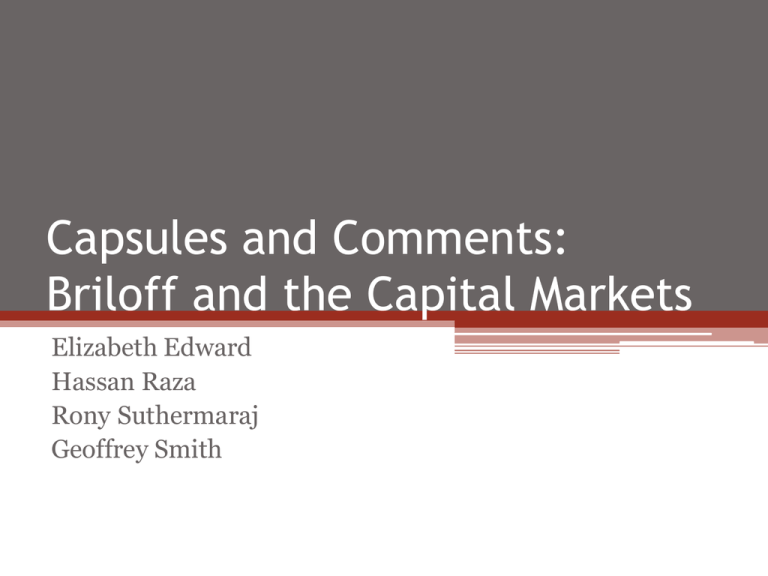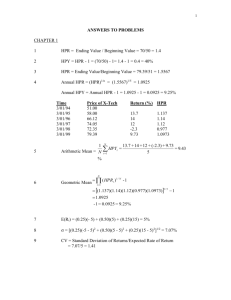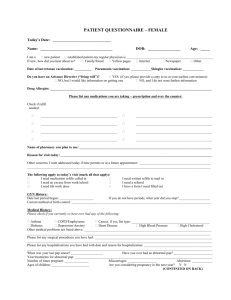Capsules_and_Comments_-_Briloff_and_the_Capital_Markets
advertisement

Capsules and Comments: Briloff and the Capital Markets Elizabeth Edward Hassan Raza Rony Suthermaraj Geoffrey Smith Intro • Abraham Briloff is a well-known accountant that is noted for being critical of the accounting methods of companies • Economist, George Foster , analyzed the effects that Abraham Briloff’s articles had on the capital market Intro • An average drop of 8% was noted in the stocks of the companies he researched when his info was released to the public • George Foster examines 5 reasons for why this occurs Capital Market Model • Two criteria used for George Foster’s examination of Briloff’s work: • -The day the article became “Publicly Available” is obtainable • -The accounting practices of specific companies must be criticized • Fifteen articles selected that included security returns on 28 companies Capital Market Model • The article mentions that announcements appear to have an effect on the capital market. • This effect is concentrated within two day period around the announcements. • Because of this Foster uses daily security returns in his analysis • He examines the security returns thirty days prior to and after the publication of Briloff’s articles Capital Market Model • The capital market equilibrium model used to describe the pricing of capital assets in the study is: • (1) E(Rit) = E (Rat) + β i[E(Rmt) – E(Rat)] where • Rit = return on asset i in period t • Rat = return on an asset whose returns are uncorrelated with Rmt in period t • Rmt = return on the market portfolio in period t • β i = relative risk of asset i Capital Market Model • Using the previous model the effect of any new information on asset i becoming available in period t can be determined as: • (2) Uit = Rit – E(Rit│Rat, Rmt, βi) where • Uit = abnormal return • Abnormal Return calculated based on the “companion portfolio” of Black and Scholes • Stocks are ranked on an estimate of beta in period t-1 and placed into twenty portfolios Capital Market Model • The abnormal return on stock i in period t is estimated using: • (3) Uit = Rit - Rpt where • Rpt = return on “companion portfolio” p in period t Cumulative Abnormal Return (C.A.R) What is it? -Sum of all the differences between the expected returns and the actual returns up to a given point in time Cumulative Abnormal Return (C.A.R) Figure 1, shows the average cumulative abnormal return (CAR) of the 28 stocks Cumulative Abnormal Return (C.A.R) Figure 2, shows The average cumulative abnormal return (CAR) of the 15 articles. Cumulative Abnormal Return (C.A.R) Figure 3, is an overlap off the first two graphs to better display the affect Briloff’s articles had on the market. The blue line represents the CAR of Briloff's articles, and the red line depicts the CAR of the 28 stocks. Kolmogorov–Smirnov Test 5 Explanations 1. 2. 3. 4. 5. The Capital Market is Inefficient Briloff Brings New Ideas to the Market Briloff’s Use of Non-public Info Sources Increased Government Regulation Uncontrollable Factors The Capital Market is Inefficient • If we assume that Briloff used information that was “costless” and available to the public, then by definition of market efficiency there should be no price reaction to Briloff’s article • Because the market was inefficient there was a price reaction to the article Briloff Brings New Ideas to the Market • Individuals can create their own analysis • This affects the ability to test the capital market efficiently • When articles such as Briloff’s are released one should predict the “appropriate” price reaction to such info releases • Compare the predicted and actual results • Timing and magnitude of the info release can play a large part in the “appropriate” price reaction Briloff’s Use of Non-public Info Sources • The data sources used by Briloff extend beyond the information set “publicly available” • Unfortunately there is no clear-cut distinction between “publicly available” and “non-publicly available” information sets Increased Government Regulation • Due to the effective way Briloff writes, he acts as a catalyst to parties who can affect the future cash flows of firms • Information on how the criticisms of a single individual influence the decisions of congressmen and bureaucrats are not easily available Uncontrollable Factors • There is always the possibility in any experiment that uncontrolled factors may cause the results observed • If the publication of each Briloff article coincides with the release of other information about the cited companies then ambiguity would exist over the cause of the results Questions • What were some of the financial analyses that George Foster used to understand Briloff’s results? Questions • Explain market inefficiency? Questions • Which of the 5 explanations do you think was the most influential to the changes in stock prices? 5 Explanations 1. 2. 3. 4. 5. The Capital Market is Inefficient Briloff Brings New Ideas to the Market Briloff’s Use of Non-public Info Sources Increased Government Regulation Uncontrollable Factors Conclusion • Timing of the price reaction is consistent with an efficient market • When research goes beyond publically available information it affects the tests of market efficiency • Results are subject to varying interpretations











